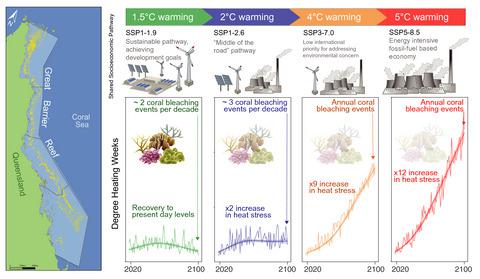当前位置:
X-MOL 学术
›
Glob. Change Biol.
›
论文详情
Our official English website, www.x-mol.net, welcomes your
feedback! (Note: you will need to create a separate account there.)
The importance of 1.5°C warming for the Great Barrier Reef
Global Change Biology ( IF 10.8 ) Pub Date : 2021-11-16 , DOI: 10.1111/gcb.15994 Jennifer K McWhorter 1, 2 , Paul R Halloran 2 , George Roff 1 , William J Skirving 3, 4 , Chris T Perry 2 , Peter J Mumby 1
Global Change Biology ( IF 10.8 ) Pub Date : 2021-11-16 , DOI: 10.1111/gcb.15994 Jennifer K McWhorter 1, 2 , Paul R Halloran 2 , George Roff 1 , William J Skirving 3, 4 , Chris T Perry 2 , Peter J Mumby 1
Affiliation

|
Tropical coral reefs are among the most sensitive ecosystems to climate change and will benefit from the more ambitious aims of the United Nations Framework Convention on Climate Change's Paris Agreement, which proposed to limit global warming to 1.5° rather than 2°C above pre-industrial levels. Only in the latest Intergovernmental Panel on Climate Change focussed assessment, the Coupled Model Intercomparison Project phase 6 (CMIP6), have climate models been used to investigate the 1.5° warming scenario directly. Here, we combine the most recent model updates from CMIP6 with a semi-dynamic downscaling to evaluate the difference between the 1.5 and 2°C global warming targets on coral thermal stress metrics for the Great Barrier Reef (GBR). By ~2080, severe bleaching events are expected to occur annually under intensifying emissions (shared socioeconomic pathway SSP5-8.5). Adherence to 2° warming (SSP1-2.6) halves this frequency but the main benefit of confining warming to 1.5° (SSP1-1.9) is that bleaching events are reduced further to 3 events per decade. Attaining low emissions of 1.5° is also paramount to prevent the mean magnitude of thermal stress from stabilizing close to a critical thermal threshold (8 Degree Heating Weeks). Thermal stress under the more pessimistic pathways SSP3-7.0 and SSP5-8.5 is three to fourfold higher than the present day, with grave implications for future reef ecosystem health. As global warming continues, our projections also indicate more regional warming in the central and southern GBR than the far north and northern GBR.
中文翻译:

1.5°C 升温对大堡礁的重要性
热带珊瑚礁是对气候变化最敏感的生态系统之一,将受益于《联合国气候变化框架公约》的《巴黎协定》更雄心勃勃的目标,该协定提议将全球变暖限制在工业化前的 1.5°而不是 2°C水平。只有在最新的政府间气候变化专门委员会重点评估中,耦合模型比对项目第 6 阶段 (CMIP6) 才使用气候模型直接研究 1.5° 变暖情景。在这里,我们将 CMIP6 的最新模型更新与半动态降尺度相结合,以评估 1.5 和 2°C 全球变暖目标在大堡礁 (GBR) 珊瑚热应力指标上的差异。到 2080 年,在排放加剧的情况下,预计每年都会发生严重的白化事件(共享社会经济路径 SSP5-8.5)。坚持 2° 升温 (SSP1-2.6) 将这一频率减半,但将升温限制在 1.5° (SSP1-1.9) 的主要好处是漂白事件进一步减少到每十年 3 次。实现 1.5° 的低排放对于防止热应力的平均幅度稳定在临界热阈值(8 度加热周)附近也至关重要。更悲观的途径 SSP3-7.0 和 SSP5-8.5 下的热应力比现在高出三到四倍,对未来的珊瑚礁生态系统健康具有严重影响。随着全球变暖的持续,我们的预测还表明,GBR 中部和南部的区域变暖程度要高于 GBR 的北部和北部。坚持 2° 升温 (SSP1-2.6) 将这一频率减半,但将升温限制在 1.5° (SSP1-1.9) 的主要好处是漂白事件进一步减少到每十年 3 次。实现 1.5° 的低排放对于防止热应力的平均幅度稳定在临界热阈值(8 度加热周)附近也至关重要。更悲观的途径 SSP3-7.0 和 SSP5-8.5 下的热应力比现在高出三到四倍,对未来的珊瑚礁生态系统健康具有严重影响。随着全球变暖的持续,我们的预测还表明,GBR 中部和南部的区域变暖程度要高于 GBR 的北部和北部。坚持 2° 升温 (SSP1-2.6) 将这一频率减半,但将升温限制在 1.5° (SSP1-1.9) 的主要好处是漂白事件进一步减少到每十年 3 次。实现 1.5° 的低排放对于防止热应力的平均幅度稳定在临界热阈值(8 度加热周)附近也至关重要。更悲观的途径 SSP3-7.0 和 SSP5-8.5 下的热应力比现在高出三到四倍,对未来的珊瑚礁生态系统健康具有严重影响。随着全球变暖的持续,我们的预测还表明,GBR 中部和南部的区域变暖程度要高于 GBR 的北部和北部。9) 是漂白事件进一步减少到每十年 3 次。实现 1.5° 的低排放对于防止热应力的平均幅度稳定在临界热阈值(8 度加热周)附近也至关重要。更悲观的途径 SSP3-7.0 和 SSP5-8.5 下的热应力比现在高出三到四倍,对未来的珊瑚礁生态系统健康具有严重影响。随着全球变暖的持续,我们的预测还表明,GBR 中部和南部的区域变暖程度要高于 GBR 的北部和北部。9) 是漂白事件进一步减少到每十年 3 次。实现 1.5° 的低排放对于防止热应力的平均幅度稳定在临界热阈值(8 度加热周)附近也至关重要。更悲观的途径 SSP3-7.0 和 SSP5-8.5 下的热应力比现在高出三到四倍,对未来的珊瑚礁生态系统健康具有严重影响。随着全球变暖的持续,我们的预测还表明,GBR 中部和南部的区域变暖程度要高于 GBR 的北部和北部。5 比现在高出三到四倍,对未来的珊瑚礁生态系统健康产生严重影响。随着全球变暖的持续,我们的预测还表明,GBR 中部和南部的区域变暖程度要高于 GBR 的北部和北部。5 比现在高出三到四倍,对未来的珊瑚礁生态系统健康产生严重影响。随着全球变暖的持续,我们的预测还表明,GBR 中部和南部的区域变暖程度要高于 GBR 的北部和北部。
更新日期:2022-01-16
中文翻译:

1.5°C 升温对大堡礁的重要性
热带珊瑚礁是对气候变化最敏感的生态系统之一,将受益于《联合国气候变化框架公约》的《巴黎协定》更雄心勃勃的目标,该协定提议将全球变暖限制在工业化前的 1.5°而不是 2°C水平。只有在最新的政府间气候变化专门委员会重点评估中,耦合模型比对项目第 6 阶段 (CMIP6) 才使用气候模型直接研究 1.5° 变暖情景。在这里,我们将 CMIP6 的最新模型更新与半动态降尺度相结合,以评估 1.5 和 2°C 全球变暖目标在大堡礁 (GBR) 珊瑚热应力指标上的差异。到 2080 年,在排放加剧的情况下,预计每年都会发生严重的白化事件(共享社会经济路径 SSP5-8.5)。坚持 2° 升温 (SSP1-2.6) 将这一频率减半,但将升温限制在 1.5° (SSP1-1.9) 的主要好处是漂白事件进一步减少到每十年 3 次。实现 1.5° 的低排放对于防止热应力的平均幅度稳定在临界热阈值(8 度加热周)附近也至关重要。更悲观的途径 SSP3-7.0 和 SSP5-8.5 下的热应力比现在高出三到四倍,对未来的珊瑚礁生态系统健康具有严重影响。随着全球变暖的持续,我们的预测还表明,GBR 中部和南部的区域变暖程度要高于 GBR 的北部和北部。坚持 2° 升温 (SSP1-2.6) 将这一频率减半,但将升温限制在 1.5° (SSP1-1.9) 的主要好处是漂白事件进一步减少到每十年 3 次。实现 1.5° 的低排放对于防止热应力的平均幅度稳定在临界热阈值(8 度加热周)附近也至关重要。更悲观的途径 SSP3-7.0 和 SSP5-8.5 下的热应力比现在高出三到四倍,对未来的珊瑚礁生态系统健康具有严重影响。随着全球变暖的持续,我们的预测还表明,GBR 中部和南部的区域变暖程度要高于 GBR 的北部和北部。坚持 2° 升温 (SSP1-2.6) 将这一频率减半,但将升温限制在 1.5° (SSP1-1.9) 的主要好处是漂白事件进一步减少到每十年 3 次。实现 1.5° 的低排放对于防止热应力的平均幅度稳定在临界热阈值(8 度加热周)附近也至关重要。更悲观的途径 SSP3-7.0 和 SSP5-8.5 下的热应力比现在高出三到四倍,对未来的珊瑚礁生态系统健康具有严重影响。随着全球变暖的持续,我们的预测还表明,GBR 中部和南部的区域变暖程度要高于 GBR 的北部和北部。9) 是漂白事件进一步减少到每十年 3 次。实现 1.5° 的低排放对于防止热应力的平均幅度稳定在临界热阈值(8 度加热周)附近也至关重要。更悲观的途径 SSP3-7.0 和 SSP5-8.5 下的热应力比现在高出三到四倍,对未来的珊瑚礁生态系统健康具有严重影响。随着全球变暖的持续,我们的预测还表明,GBR 中部和南部的区域变暖程度要高于 GBR 的北部和北部。9) 是漂白事件进一步减少到每十年 3 次。实现 1.5° 的低排放对于防止热应力的平均幅度稳定在临界热阈值(8 度加热周)附近也至关重要。更悲观的途径 SSP3-7.0 和 SSP5-8.5 下的热应力比现在高出三到四倍,对未来的珊瑚礁生态系统健康具有严重影响。随着全球变暖的持续,我们的预测还表明,GBR 中部和南部的区域变暖程度要高于 GBR 的北部和北部。5 比现在高出三到四倍,对未来的珊瑚礁生态系统健康产生严重影响。随着全球变暖的持续,我们的预测还表明,GBR 中部和南部的区域变暖程度要高于 GBR 的北部和北部。5 比现在高出三到四倍,对未来的珊瑚礁生态系统健康产生严重影响。随着全球变暖的持续,我们的预测还表明,GBR 中部和南部的区域变暖程度要高于 GBR 的北部和北部。











































 京公网安备 11010802027423号
京公网安备 11010802027423号